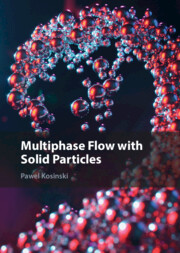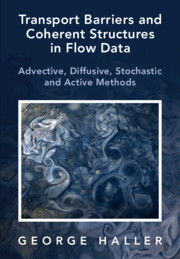46 results
2 - Formulation of the Population Balance
-
- Book:
- Population Balance of Particles in Flows
- Published online:
- 14 November 2024
- Print publication:
- 21 November 2024, pp 24-58
-
- Chapter
- Export citation
6 - Gravitational Sources
-
- Book:
- An Introduction to Gravity
- Published online:
- 04 May 2024
- Print publication:
- 11 April 2024, pp 211-246
-
- Chapter
- Export citation

Multiphase Flow with Solid Particles
-
- Published online:
- 05 October 2023
- Print publication:
- 19 October 2023

Fluid Dynamics of Particles, Drops, and Bubbles
-
- Published online:
- 28 July 2023
- Print publication:
- 17 August 2023
2 - Eulerian and Lagrangian Fundamentals
-
- Book:
- Transport Barriers and Coherent Structures in Flow Data
- Published online:
- 20 February 2023
- Print publication:
- 16 March 2023, pp 13-59
-
- Chapter
- Export citation
1 - Introduction
-
- Book:
- Transport Barriers and Coherent Structures in Flow Data
- Published online:
- 20 February 2023
- Print publication:
- 16 March 2023, pp 1-12
-
- Chapter
-
- You have access
- Export citation

Transport Barriers and Coherent Structures in Flow Data
- Advective, Diffusive, Stochastic and Active Methods
-
- Published online:
- 20 February 2023
- Print publication:
- 16 March 2023
2 - The Material Derivative: The First Step to the Navier–Stokes Equations
-
- Book:
- A Student's Guide to the Navier-Stokes Equations
- Published online:
- 10 March 2023
- Print publication:
- 09 February 2023, pp 32-59
-
- Chapter
- Export citation
4 - The Navier–Stokes Equations: Another Approach
-
- Book:
- A Student's Guide to the Navier-Stokes Equations
- Published online:
- 10 March 2023
- Print publication:
- 09 February 2023, pp 102-123
-
- Chapter
- Export citation
3 - Force Balance, the Stress Tensor, and the Navier–Stokes Equations
-
- Book:
- A Student's Guide to the Navier-Stokes Equations
- Published online:
- 10 March 2023
- Print publication:
- 09 February 2023, pp 60-101
-
- Chapter
- Export citation
1 - Mass Conservation and the Continuity Equation
-
- Book:
- A Student's Guide to the Navier-Stokes Equations
- Published online:
- 10 March 2023
- Print publication:
- 09 February 2023, pp 1-31
-
- Chapter
- Export citation
6 - Nondimensionalization and Scaling
-
- Book:
- A Student's Guide to the Navier-Stokes Equations
- Published online:
- 10 March 2023
- Print publication:
- 09 February 2023, pp 182-219
-
- Chapter
- Export citation
5 - The Energy Equation and a Discussion on Diffusion and Advection
-
- Book:
- A Student's Guide to the Navier-Stokes Equations
- Published online:
- 10 March 2023
- Print publication:
- 09 February 2023, pp 124-181
-
- Chapter
- Export citation
3 - Blood in Motion, or the Physics of Blood Flow
-
-
- Book:
- Blood
- Published online:
- 13 June 2022
- Print publication:
- 07 July 2022, pp 38-64
-
- Chapter
- Export citation

Wildland Fire Dynamics
-
- Published online:
- 16 June 2022
- Print publication:
- 30 June 2022

Blood
-
- Published online:
- 13 June 2022
- Print publication:
- 07 July 2022
SOLUTIONS TO DIFFERENTIAL EQUATIONS VIA FIXED POINT APPROACHES: NEW MATHEMATICAL FOUNDATIONS AND APPLICATIONS
- Part of
-
- Journal:
- Bulletin of the Australian Mathematical Society / Volume 106 / Issue 1 / August 2022
- Published online by Cambridge University Press:
- 09 June 2022, pp. 163-164
- Print publication:
- August 2022
-
- Article
-
- You have access
- HTML
- Export citation
A DYNAMICAL STUDY OF SALINE PLUMES IN DESALINATION OUTFALLS
- Part of
-
- Journal:
- Bulletin of the Australian Mathematical Society / Volume 105 / Issue 3 / June 2022
- Published online by Cambridge University Press:
- 01 March 2022, pp. 523-524
- Print publication:
- June 2022
-
- Article
-
- You have access
- HTML
- Export citation
18 - Shiraz Minwalla
-
- Book:
- Conversations on Quantum Gravity
- Published online:
- 05 August 2021
- Print publication:
- 26 August 2021, pp 351-372
-
- Chapter
- Export citation
Xanthene-stained nanoparticles for phosphorescence anisotropy measurements
-
- Journal:
- Experimental Results / Volume 2 / 2021
- Published online by Cambridge University Press:
- 07 July 2021, e20
-
- Article
-
- You have access
- Open access
- HTML
- Export citation

